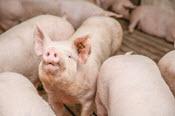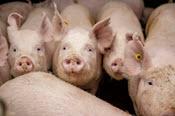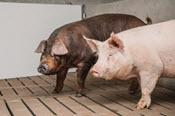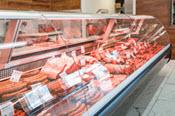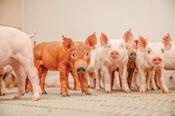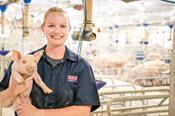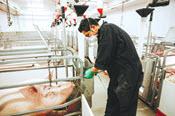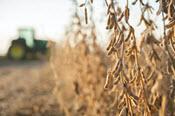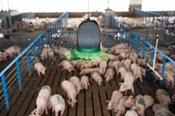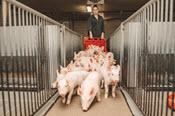Better Pork is published bimonthly. After each edition is published, we share two feature articles online. Each magazine includes much more content. If you enjoy reading the Better Pork articles below, be sure to subscribe to the magazine!
Infectious Pig Diseases are a Problem for Both Producers & Consumers.
By Qiang Zhang & Amy La, University Of Manitoba
For producers, diseases can cause a loss of productivity both in mortality and growth and increase the costs associated with medical care and bio-security (Holtkamp et al. 2013).
For consumers, disease spread will cause shortages and price increases of pork products as well as food safety concerns.
Tasting Success with Electronic Sow Feeders
By Geoff Geddes
Though the lack of opposable thumbs keeps them from cracking a textbook, pigs are fast learners. As a result, high-tech systems like electronic sow feeders (ESF) are a solid option on-farm to get the most from your animals while reducing feed wastage.
For the best results, however, workers must also learn the ropes and be well-versed in such systems. By focusing on proper training, you can ensure that your pigs and your people are set up for success.
How Do We Help Pigs During Heat Stress?
By Maude Richer-Lanciault & Marion Mogire
For many of us, the hot days of summer are a welcomed change from our long Canadian winters – but for our pig barns the warm and humid weather conditions can create the opportunity for performance and profitability losses.
Meteorologists predict that we should expect above-average temperatures in the coming years, and that summers will start earlier than in previous years. With this, heat stress in pig production will become a bigger concern across Canada.
Consumer Demand Stays Strong During Rising Grocery Prices.
By Emily Croft
The cost of living has been increasing and many Canadians are concerned about the rising cost of groceries. Consumers may become more selective to save money, leading to concerns about the impact on meat demand and what it might mean for profits on pork and other livestock farms.
In September 2022, Statistics Canada stated that the yearly price increase for food purchased in stores was the greatest it had been since 1981.
By Fiona Tansil, Trouw Nutrition Canada
Weaning age varies from one farm to another. Some might wean at an earlier age depending on the number of sows farrowing each week or due to limitation in the farrowing capacity. On the other hand, some might wean later due to the potential improvement in nursery and grow-finish performance.
This article will discuss the potential impacts of weaning at age 19 and 24 days on growth and production parameters using the cutting-edge Watson model and Scenario software developed by Trouw Nutrition.
By Victoria Seip Eisses, Grand Valley Fortifiers
As both the hog and commodity markets continue to show great volatility and variability, feed budgeting is extremely important to make sure we are maximizing both the feed cost and performance of our commercial animals.
We continue to see rising feed prices which, in turn, has made us alter what we are feeding in order to maximize on ingredients and efficiency. Efficiency is key because as long as hogs are not backlogged, feed conversion is more important than ever.
Are your pigs up to potential health challenges?
By Colleen Halpenny
As many producers face problematic labour shortages, much emphasis has been placed on working with pigs which require less labour time.
The highest negative cost is time spent managing illness in the herd, and researchers are working to find new ways to improve swine resiliency.
Dr. Pramod Mathur, senior geneticist and director of research and development for Topigs Norsvin Canada, has seen an increasing focus on vitality in the past few years.
‘Improving the thickness of bellies, without compromising lean percentage’
By Lauren Quinn, College of Agricultural, Consumer and Environmental Sciences at the University of Illinois Urbana-Champaign
Adding a fat source to the traditional corn-soy swine diet is common practice, but the type of fat can make a difference both for growing pigs and carcass quality. Polyunsaturated fats, the primary type in dried distillers’ grains with solubles (DDGS), can reduce fat quality and complicate processing of pork bellies and bacon.
Where the ‘next big thing’ is always king
By Geoff Geddes
Everywhere you turn, technology has been changing our world for the better: desktop computers, smartphones, beer hats. For the pork sector, staying competitive in pork means keeping up with the latest advances. Apart from being interesting and cool, hi-tech takes the heat off producers in an industry that offers two options: keep up or go under.
Data can be used to determine where to look for the causes of animal losses.
By Emily Croft
Herd data is an important tool that can be used by producers to benchmark their herd, determine their strengths, and identify areas for improvement on their farm. Gilt retention is a topic of increasing interest where data can be used for management decisions, maximizing the potential of the females entering the herd. Identification of issues in gilt retention may also be used to examine other underlying problems.



